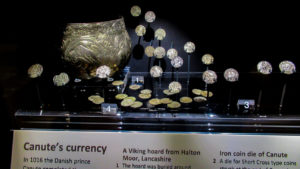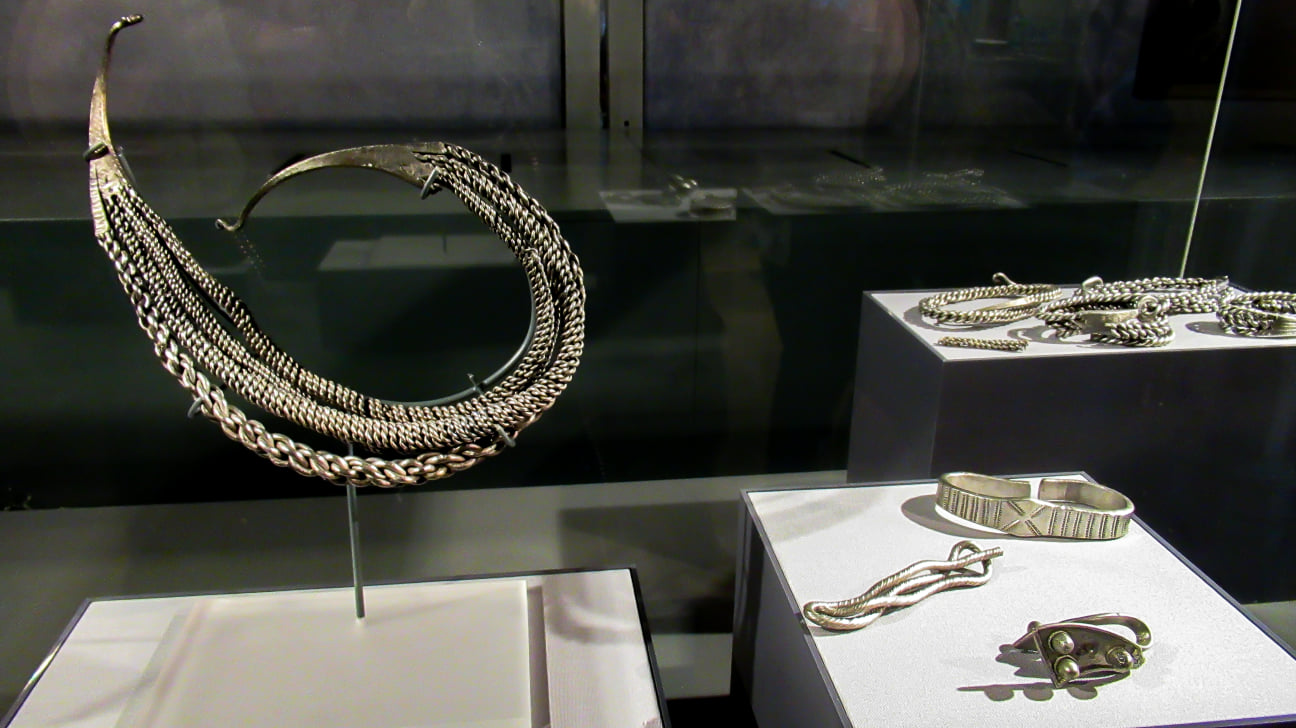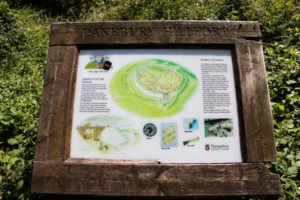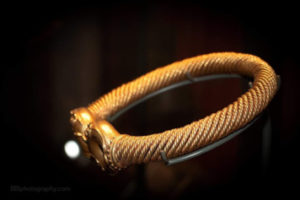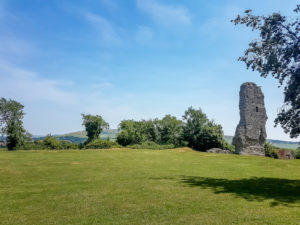Scandinavian York, referred to at the time as Jórvík or Danish York is a term used by historians for the south of Northumbria (modern-day Yorkshire) during the period of the late 9th century and the first half of the 10th century, when it was dominated by Norse warrior-kings; in particular, it is used to refer to York, the city controlled by these kings.
From 1976 to 1981, the York Archaeological Trust conducted a five-year excavation in and around the street of Coppergate in central York. This demonstrated that, in the 10th century, Jórvík’s trading connections reached to the Byzantine Empire and beyond: a cap made of silk survives, and coins from Samarkand were familiar enough and respected enough for a counterfeit to have passed in trade. Both these items, as well as a large human coprolite known as the Lloyds Bank coprolite, were famously recovered in York a millennium later. Amber from the Baltic is often expected at a Viking site and at Jórvík an impractical and presumably symbolic axehead of amber was found. A cowrie shell indicates contact with the Red Sea or the Persian Gulf. Christian and pagan objects have survived side-by-side, usually taken as a sign that Christians were not in positions of authority.
After the excavation, the York Archaeological Trust took the decision to recreate the excavated part of Jórvík on the Coppergate site, and this is now the Jorvik Viking Centre.
History
Norse monarchy controlled varying amounts of Northumbria from 875 to 954; however, the area was invaded and conquered for short periods by Anglo-Saxons between 927 and 954 before eventually being annexed by them in 954. It was closely associated with the much longer-lived Kingdom of Dublin throughout this period.
York had been founded as the Roman legionary fortress of Eboracum and revived as the Anglo-Saxon trading port of Eoforwic. It was first captured in November 866 by Ivar the Boneless, leading a large army of Danish Vikings, called the “Great Heathen Army” by Anglo-Saxon chroniclers, which had landed in East Anglia and made their way north, aided by a supply of horses with which King Edmund of East Anglia bought them off and by civil in-fighting between royal candidates in the Anglian Kingdom of Northumbria between the leaders of its two sub-kingdoms; Bernicia and Deira. Declaring a truce, the rivals for the throne of Northumbria joined forces but failed to retake the city in March 867, and with their deaths, Deira came under Danish control as the Kingdom of Northumbria and the Northumbrian royal court fled north to refuge in Bernicia.
A Viking attempt against Mercia the same season failed, and in 869 their efforts against Wessex were fruitless in the face of opposition from Kings Ethelred and Alfred the Great. The archbishop, Wulfhere, seems to have temporized and collaborated with the Norse, for he was expelled from York when a Northumbrian uprising in 872 was only temporarily successful; he was recalled and held his seat until his death. The Viking king Guthred was buried in York Minster, a signal that he and the archbishop had reached a lasting accommodation. All the Viking coinage appears to have emanated from the mint at York, a mark of the city’s unique status in Northumbria as an economic magnet. York’s importance as the seat of Northumbria was confirmed when the Scandinavian warlord, Guthrum, headed for East Anglia, while Halfdan Ragnarsson seized power in 875. While the Danish army was busy in Britain, the Isle of Man, and Ireland, the Swedish army was occupied with defending the Danish and Swedish homelands where Halfdan’s brothers were in control.
Native Danish rulers who eventually made Jelling in Jutland the site of Gorm the Old’s kingdom were in the East Anglian kingdom. The Five Burghs/Jarldoms were based upon the Kingdom of Lindsey and were a sort of frontier between each kingdom. King Canute the Great would later “reinstall” a Norwegian dynasty of jarls in Northumbria (Eric of Hlathir), with a Danish dynasty of jarls in East Anglia (Thorkel). Northern England would continue to be a source of intrigue for the Norwegians until Harald III of Norway’s death at the Battle of Stamford Bridge in 1066 just prior to the Battle of Hastings and the Norman conquest.
The Old Norse placename Konungsgurtha, Kings Court, recorded in the late fourteenth century in relation to an area immediately outside the site of the porta principalis sinistra, the east gatehouse of the Roman encampment, perpetuated today as King’s Square, which nucleates the Ainsty, perhaps indicates a Viking royal palace site based on the remains of the east gate of the Roman fortress.[5] New streets, lined by regular building fronts for timber houses were added to an enlarging city between 900 and 935, dates arrived at by tree-ring chronology carried out on remaining posts preserved in anaerobic clay subsoil.
With the violent death of the last King of York, Eric Bloodaxe, in 954, the Viking kingdom was fully absorbed into England. After the Kingdom of Northumbria was remerged (by now an Earldom of England under the House of Wessex), the title King of Jórvík became redundant and was succeeded by the title Earl of York, created in 960. Loss of political independence did not cramp the region’s economic success: by ca 1000, the urban boom brought the city to a population total second only to that of London within Great Britain.
Although some of the early Earls of York were Nordic like the Jórvík Kings, they were succeeded by Normans after the Norman conquest. William the Conqueror ended the region’s last vestiges of independence and established garrisoned castles in the city.

